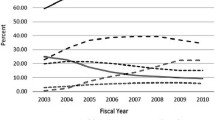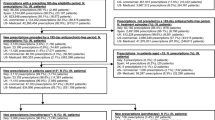Abstract
Background
The California Medicaid Program (Medi-Cal) provided open access to atypical antipsychotics in October 1997. This study investigated the impact of open access to atypical antipsychotics on the costs and duration of therapy for patients with bipolar disorders.
Methods
Paid claims data from Medi-Cal were used to identify episodes of treatment using antipsychotics, antidepressants, mood stabilizers, or selected anticonvulsants initiated by patients with bipolar disorders. Episodes of treatment were assigned to one of three time periods based on the start date: closed access (July 1994 to September 1997); a transition period (October 1997 to March 1998); and open access (April 1998 to August 1999). Ordinary least squares models for the cost and duration of drug therapy were estimated for episodes of treatment started after a break in all bipolar-related drug therapy (restarts) and switching/augmentation episodes.
Results
123 796 restart and 206 157 switching/augmentation episodes were identified. Patients with bipolar disorders cost between $US8000 and $US9000 annually (year of values 1998). Open access increased total costs by $US165–203 per year for restart episodes and $US75–125 per year for switching/augmentation episodes, primarily due to increased drug costs of $US101–103 for restart episodes (p < 0.001) and $US124 for switching/augmentation episodes (p < 0.001). Days of therapy decreased by 3.67 days for restart episodes (p < 0.001) and increased by 2.59–2.62 days for switching/augmentation episodes (p < 0.001) from the closed access period to the open access period.
Conclusions
Conventional antipsychotic medications are not used for long-term drug therapy for bipolar disorders, and the long-term effectiveness of atypical antipsychotics was not well established in October 1997. It is not surprising that open access to atypical antipsychotics had only limited effects on the costs and duration of therapy for these patients.











Similar content being viewed by others
References
Nemeroff CB. An ever-increasing pharmacopoeia for the management of patients with bipolar disorder. J Clin Psychiatry 2000; 61 Suppl. 13: 19–25
Woods SW. The economic burden of bipolar disease. J Clin Psychiatry 2000; 61 Suppl. 13: 38–41
Weissman MM, Bland RC, Canino GJ, et al. Cross-national epidemiology of major depression and bipolar disorder. JAMA 1996; 276: 293–9
Kessler RC, McGonagle KA, Zhao S, et al. Lifetime and 12-month prevalence of DSM-III-R psychiatric disorders in the United States. Arch Gen Psychiatry 1994; 51: 8–19
Kessler RC, Berglund P, Dernier O, et al. Lifetime prevalence and age-of-onset distributions of DSM-IV disorders in the National Comorbidity Survey Replication. Arch Gen Psychiatry 2005; 62(6): 593–602
Hirschfeld RM, Lewis L, Vornik LA. Perceptions and impact of bipolar disorder: how far have we really come? Results of the National Depressive and Manic-depressive Association 2000 survey of individuals with bipolar disorder. J Clin Psychiatry 2003; 64(2): 161–74
Jamison KR. Suicide and bipolar disorder. J Clin Psychiatry 2000; 61 Suppl. 9: 47–51
Baldessarini RJ, Tondo L. Suicide risk and treatments for patients with bipolar disorder [editorial? JAMA 2003; 290(11): 1517–9
Judd LL, Akiskal HS, Schettler PJ, et al. The long-term natural history of the weekly symptomatic status of bipolar I disorder. Arch Gen Psychiatry 2002; 59: 530–537
Tondo L, Baldessarini RJ. Reduced suicide risk during lithium maintenance treatment. J Clin Psychiatry 2000; 61 Suppl. 9: 97–105
Angst J, Angst F, Stassen HH. Suicide risk in patients with major depressive disorder. J Clin Psychiatry 1999; 60 Suppl. 2: 57–62
Angst F, Stassen HH, Clayton PJ. Mortality of patients with mood disorders: follow-up over 34–38 years. J Affect Disord 2002; 68: 167–81
Perugi G, Akiskal HS, Ramacciotti S. Depressive comorbidity of panic, social phobic, and obsessive-compulsive disorders re-examined: is there a bipolar II connection? J Psychiatr Res 1999; 33: 53–61
Begley CE, Annegers JF, Swann AC. The lifetime cost of bipolar disorder in the US: an estimate for new cases in 1998. Pharmacoeconomics 2001; 19(5): 483–96
Wyatt RJ, Henter I. An economic evaluation of manic-depressive illness — 1991. Soc Psychiatry Psychiatr Epidemiol 1995; 30: 213–9
Stender M, Bryant-Comstock L, Phillips S. Medical resource use among patients treated for bipolar disorder: a retrospective, cross-sectional, descriptive analysis. Clinical Therapeutics 2002; 24(10): 1668–76
American Psychiatric Association. Practice guideline for the treatment of patients with bipolar disorder. J Clin Psychiatry 1994; 151 Suppl. 12: 1–36
Calabrese JR, Keck Jr PE, Macfadden W, et al. A randomized, double-blind, placebo-controlled trial of quetiapine in the treatment of bipolar I and II depression. Am J Psychiatry 2005; 162(7): 1351–60
Keck Jr PE, McElroy SL, Strakowski SM, et al. Compliance with maintenance treatment in bipolar disorder. Psychopharmacol Bull 1997; 33: 87–91
Li J, McCombs JS, Stimmel GL. Cost of treating bipolar disorder in the California Medicaid (Medi-Cal) program. J Affect Disord 2002; 71: 131–9
McCombs JS, Luo M, Johnstone BM. The use of conventional antipsychotics medications for patients with schizophrenia in a Medicaid population: therapeutic and cost outcomes over 2 years. Value in Health 2000; 3(2): 222–31
McCombs JS. Antipsychotic drug use patterns and the cost of treating schizophrenia. Psychiatr Serv 2000; 51: 525–7
Lyu RR, McCombs JS, Johnstone BM. Use of conventional antipsychotics and the cost of treating schizophrenia. Health Care Financ Rev 2001; 23(2): 83–99
McCombs JS, Nichol MB, Stimmel GL. Use patterns for antipsychotic medications in Medicaid patients with schizophrenia. J Clin Psychiatry 1999; 60 Suppl. 19: 5–13
California’s Medical Assistance Program. Medi-Cal top 100 drug use report: 1999 year-to-date through June 1999. Sacramento (CA): Medical Care Statistics Section, Department of Health Services, 1999
McCombs JS, Mulani P, Gibson PJ. Open access to innovative drugs: treatment substitutions or treatment expansion? Health Care Financ Rev 2004; 25(3): 35–53
McCombs JS, Shi L, Croghan TW. Access to drug therapy and substitution between alternative antidepressants following an expansion of the California Medicaid formulary. Health Policy 2003; 65: 301–11
McCombs JS, Shi L, Stimmel GL. A retrospective analysis of the revocation of prior authorization restrictions and the use of antidepressant medications for treating major depressive disorder. Clin Ther 2002; 24(11): 1939–59
Kahn D, Frances A, Docherty J. Expert consensus guideline series: treatment of bipolar disorder. J Clin Psychiatry 1996; 57 Suppl. 12A: 1–89
Goldberg JF. Treatment guidelines: current and future management of bipolar disorder. J Clin Psychiatry 2000; 61 Suppl. 13: 12–8
Keck PE, McElroy SL, Strackowski SM. 12-month outcome of patients with bipolar disorder following hospitalization for a major or mixed episode. Am J Psychiatry 1998; 155: 646–52
California’s Medical Assistance Program. Annual statistical report: calendar year 1997. Sacramento (CA): Medical Care Statistics Section, Department of Health Services, 1998
US Department of Health and Human Services, Health Care Financing Administration. Medicare and Medicaid statistical supplement, 1996. Health Care Financ Rev Stat Suppl 1996; 1-472
Schneeweiss S, Maclure M, Soumerai SB, et al. Quasi-experimental longitudinal designs to evaluate drug benefit policy changes with low policy compliance. J Clin Epidemiol 2002; 55: 833–41
White H. A heteroscedasticity-consistent covariance matrix estimator and a direct test for heteroscedasticity. Econometrica 1980; 48: 817–38
Birnbaum HG, Shi L, Dial E. Economic consequences of not recognizing bipolar disorder patients: a cross-sectional descriptive analysis. J Clin Psychiatry 2003; 64(10): 1201–9
Shi L, Thiebaud P, McCombs JS. The impact of unrecognized bipolar disorders for patients treated for depression with antidepressants in the fee-for-service California Medicaid (Medi-Cal) program. J Affect Disord 2004; 82: 373–83
McCombs JS, Ahn J, Tencer T, et al. The impact of unrecognized bipolar disorders among patients treated for depression with antidepressants in the fee-for-service California Medicaid (Medi-Cal) program: a 6-year retrospective analysis. J Affect Disord. In press
Acknowledgments
This research was funded by Eli Lilly and Company, makers of olanzapine, in the form of Fellowships for Dr Narayan and Dr Sterling. The University of Southern California retains publication rights to all study results subject to time-limited review and comment by Eli Lilly and Company. The authors have no other conflicts of interest relevant to this manuscript.
Author information
Authors and Affiliations
Corresponding author
Rights and permissions
About this article
Cite this article
Narayan, S., Sterling, K.L. & McCombs, J.S. The Impact of Open Access to Atypical Antipsychotics on Treatment Costs for Medi-Cal Patients with Bipolar Disorder. Dis-Manage-Health-Outcomes 14, 287–301 (2006). https://doi.org/10.2165/00115677-200614050-00004
Published:
Issue Date:
DOI: https://doi.org/10.2165/00115677-200614050-00004




